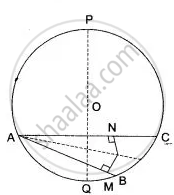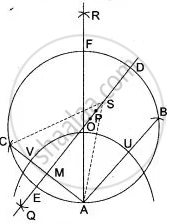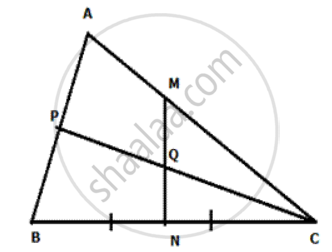Advertisements
Advertisements
प्रश्न
Use ruler and compasses only for this question. Draw a circle of radius 4 cm and mark two chords AB and AC of the circle of length f 6 cm and 5 cm respectively.
(i) Construct the locus of points, inside the circle, that are equidistant from A and C. Prove your construction.
(ii) Construct the locus of points, inside the circle, that are equidistant from AB and AC.
उत्तर १
(I) Draw PQ, the perpendicular bisector of chord AC. PQ is the required locus, which is the diameter of the circle.
Reason: We know each point on the perpendicular bisector of AB is equidistant from A and B. Also the perpendicular bisector of a chord, passes through the centre of the circle and any chord passing through the centre of the circle is its diameter.
∴ PQ is the diameter of the circle.
(ii) Chords AB and AC intersects at M and N is a moving point such that LM = LN, where LM ⊥ AB and LN ⊥ AC
In right ΔALN and ΔALB
∠ANL = ∠ABL ...(90° each)
AL = AL ...(Common)
NL = BL ...[Given]
∴ ΔALN = ΔALB ...[R.H.S.]
Hence ∠MAL = ∠BAL ...c.p.c.t.
Thus, L lies on the bisector of ∠BAC.
Hence proved.
उत्तर २
Draw a circle of radius 4 cm whose centre is O. Take a point A on the circumference of this circle.
With A as centre and radius 6 cm draw an arc to cut the circumference at B. Join AB.
Then AB is the chord of the circle of length 6 cm.
With A as centre and radius 5 cm draw another arc to cut the circumference at C. Join AC then AC is the chord of the circle of length 5 cm.
With A as centre and a suitable radius, draw two arcs on opposite sides of AC.
With C as centre and the same radius, draw two arcs on opposite sides of AC to intersect the former arcs at P and Q.
Join PQ and produce to cut the circle at D and E.
Join DE. Then chord DE is the locus of points inside the circle that Ls equidistant from A and C.
As chord DE passes through (he centre O of the circle, it is a diameter. To prove the construction take any point S inside the circle on DE.
APPEARS IN
संबंधित प्रश्न
Construct a triangle ABC with AB = 5.5 cm, AC = 6 cm and ∠BAC = 105°
Hence:
1) Construct the locus of points equidistant from BA and BC
2) Construct the locus of points equidistant from B and C.
3) Mark the point which satisfies the above two loci as P. Measure and write the length of PC.
Ruler and compasses may be used in this question. All construction lines and arcs must be clearly shown and be of sufficient length and clarity to permit assessment.
- Construct a ΔABC, in which BC = 6 cm, AB = 9 cm and angle ABC = 60°.
- Construct the locus of all points inside triangle ABC, which are equidistant from B and C.
- Construct the locus of the vertices of the triangles with BC as base and which are equal in area to triangle ABC.
- Mark the point Q, in your construction, which would make ΔQBC equal in area to ΔABC, and isosceles.
- Measure and record the length of CQ.
Draw a straight line AB of 9 cm. Draw the locus of all points which are equidistant from A and B. Prove your statement.
Two straight roads AB and CD cross each other at Pat an angle of 75° . X is a stone on the road AB, 800m from P towards B. BY taking an appropriate scale draw a figure to locate the position of a pole, which is equidistant from P and X, and is also equidistant from the roads.
In the given figure ABC is a triangle. CP bisects angle ACB and MN is perpendicular bisector of BC. MN cuts CP at Q. Prove Q is equidistant from B and C, and also that Q is equidistant from BC and AC.

Draw and describe the lorus in the following cases:
The locus of points at a distance of 4 cm from a fixed line.
Draw and describe the locus in the following cases :
The locus of a point in the rhombus ABCD which is equidistant from the point A and C
Construct a triangle BPC given BC = 5 cm, BP = 4 cm and .
i) complete the rectangle ABCD such that:
a) P is equidistant from AB and BCV
b) P is equidistant from C and D.
ii) Measure and record the length of AB.
Use ruler and compasses only for the following questions:
Construct triangle BCP, when CB = 5 cm, BP = 4 cm, ∠PBC = 45°.
Complete the rectangle ABCD such that :
(i) P is equidistant from AB and BC and
(ii) P is equidistant from C and D. Measure and write down the length of AB.
Ruler and compasses only may be used in this question. All construction lines and arcs must be clearly shown, and be of sufficient length and clarity to permit assessment.
(i) Construct a ΔABC, in which BC = 6 cm, AB = 9 cm and ∠ABC = 60°.
(ii) Construct the locus of the vertices of the triangles with BC as base, which are equal in area to ΔABC.
(iii) Mark the point Q, in your construction, which would make ΔQBC equal in area to ΔABC, and isosceles.
(iv) Measure and record the length of CQ.
